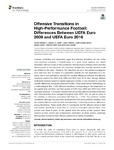Mostrar o rexistro simple do ítem
Offensive Transitions in High-Performance Football: Differences Between UEFA Euro 2008 and UEFA Euro 2016
| dc.contributor.author | Maneiro, Rubén | |
| dc.contributor.author | Casal, Claudio Alberto | |
| dc.contributor.author | Álvarez, Isaac | |
| dc.contributor.author | Moral-García, José Enrique | |
| dc.contributor.author | López García, Sergio | |
| dc.contributor.author | Ardá Suárez, Antonio | |
| dc.contributor.author | Losada, J.L. | |
| dc.date.accessioned | 2019-07-08T11:50:05Z | |
| dc.date.available | 2019-07-08T11:50:05Z | |
| dc.date.issued | 2019 | |
| dc.identifier.citation | Maneiro R, Casal CA, Álvarez I, Moral JE, López S, Ardá A and Losada JL (2019) Offensive Transitions in High-Performance Football: Differences Between UEFA Euro 2008 and UEFA Euro 2016. Front. Psychol. 10:1230. doi: 10.3389/fpsyg.2019.01230 | es_ES |
| dc.identifier.issn | 1664-1078 | |
| dc.identifier.uri | http://hdl.handle.net/2183/23425 | |
| dc.description.abstract | [Abstract] Coaches, footballers and researchers agree that offensive transitions are one of the most important moments in football today. In a sport where defense over attack dominates, with low scores on the scoreboard, the importance of these actions from the offensive point of view becomes very important. Despite this, scientific literature is still very limited on this topic. Therefore, the objectives set out in the present investigation have been two: first, by means of a proportion analysis and the application of a chisquare test, it was intended to describe the possible differences between the offensive transitions made in the UEFA Euro 2008 and UEFA Euro 2016; then, through different multivariate analyzes based on logistic regression models, it was intended to know the possible differences among the proposed models. Using observational methodology as a methodological filter, 1,533 offensive transitions corresponding to the observation of the quarter final, semifinal, and final quarter of UEFA Euro 2008 and UEFA Euro 2016 have been analyzed. The results obtained have shown that offensive transitions between both championships have changed throughout both UEFA Euro, as well as some of the variables or behaviors associated with them (p < 0.05). The predictive models considered, although they have been developed from the same predictor variables, have also yielded different results for both championships, evidencing predictive differences among themselves. These results allow to corroborate that the offensive phase in high level football, specifically in what refers to moments of transition defense-attack, have evolved over these 8 years. At the applied level, the results of this research allow coaches to have current and contemporary information on these actions, potentially allowing them to improve their offensive performance during competition | es_ES |
| dc.description.sponsorship | Ministerio de Economía y Competitividad; Grant DEP2015-66069-P | es_ES |
| dc.description.sponsorship | Ministerio de Economía y Competitividad; PSI2015-71947-REDP | es_ES |
| dc.description.sponsorship | Generalitat Valenciana; Grant GV2017-004 | es_ES |
| dc.description.sponsorship | Generalitat de Catalunya; Grant Number 2014 SGR 971 | es_ES |
| dc.language.iso | eng | es_ES |
| dc.relation.uri | https://doi.org/10.3389/fpsyg.2019.01230 | es_ES |
| dc.rights | Atribución 4.0 Internacional | es_ES |
| dc.rights.uri | http://creativecommons.org/licenses/by/4.0/ | * |
| dc.subject | Offensive transitions | es_ES |
| dc.subject | Football | es_ES |
| dc.subject | High performance | es_ES |
| dc.subject | Mixed methods | es_ES |
| dc.subject | Observational methodology | es_ES |
| dc.title | Offensive Transitions in High-Performance Football: Differences Between UEFA Euro 2008 and UEFA Euro 2016 | es_ES |
| dc.type | info:eu-repo/semantics/article | es_ES |
| dc.rights.access | info:eu-repo/semantics/openAccess | es_ES |
| UDC.journalTitle | Frontiers in Psychology | es_ES |
| UDC.volume | 10 | es_ES |
Ficheiros no ítem
Este ítem aparece na(s) seguinte(s) colección(s)
-
GI-PHG - Artigos [118]






